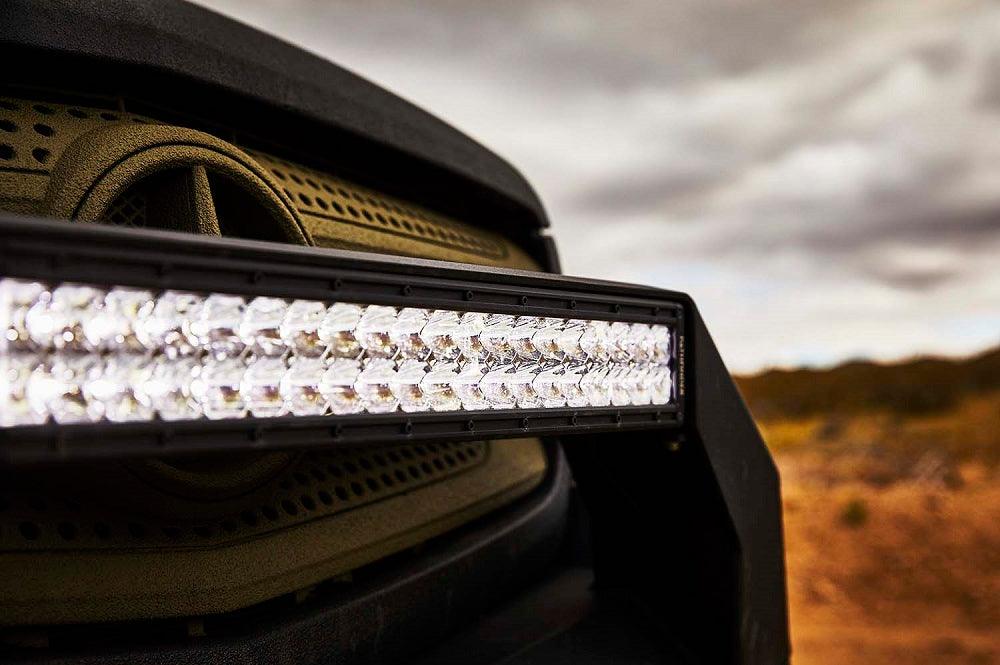It’s dark out there, really dark. If you’re an avid overlander, you know this is true. Standard high and low beam lights on your truck or van aren’t sufficient to help you safely navigate trails through the woods at night, nor will they help you make camp when you arrive after the sunsets. At Backwoods Adventure Mods, our lighting collection offers a variety of outstanding offroad lighting solutions designed to light up every part of your next adventure.
When shopping for off-road lighting, talking about bulbs and beams is essential.
1. Bulbs
Off-road lights come in three basic types:
Halogen
Halogen bulbs are the standard. They’ve been around for a long time – over 100 years. They are inexpensive and produce good light, so halogen bulbs are standard on many vehicles.
Pros: Halogen bulbs are inexpensive in the short term.
Cons: Halogen bulbs don’t last very long, which often eats up their short-term savings. They’re also inefficient. Less than 4% of the energy consumed by halogen bulbs goes to producing light; the rest is wasted as heat. Yes, they don’t cost much to replace, but you have to replace them frequently, especially if you’re a regular off-roader.
HID
High-intensity Discharge bulbs are a higher-tech version of halogen bulbs. In HID bulbs, an electric arc is sent between two tungsten electrodes that reside in an arc tube filled with gas, typically xenon, and metal salts. You’ll often see HID lights referred to as xenon lights.
Pros: HID bulbs are very efficient, producing the most visible light per wattage, which last a long time. Since they don’t use filaments, they are a durable option for off-roading. HIDs produce a clean, clear light without the glow of halogens, and they’re priced between halogen and LED bulbs.
Cons: HIDs are a good option. Their only cons are that they are more expensive than halogen and that the brightness of their light can cause glare for other drivers on the road.
LED
Light-emitting Diode bulbs are a completely different technology than halogen or HID. LEDs are a solid-state technology instead of creating light using filaments or electrodes in a vacuum tube. In very basic terms, in an LED bulb, light is created by the movement of electrons within a semiconductor material. It’s more complicated than that, but this is an off-roading blog, not an electrical engineering blog, so we’ll leave it at that.
Pros: Nothing beats LED bulbs for efficiency and durability. They don’t draw much from your vehicle’s electrical power, and they last a crazy long time, even when driving over bumpy roads. And LEDs look amazing; they generate an eye-catching, crystal-clear light.
Cons: LED bulbs are expensive compared to the alternatives. They also generate heat; the LEDs don’t heat up, but a lot of heat gets spread to the emitters (again, there’s some engineering involved here), so they require an additional component to disperse that heat which adds to the cost.
The other issue to consider when thinking about bulbs is color. Not all bulbs give off the same color light. Most vehicle lights are either white or amber. White lights are brighter than amber lights and generally result in better visibility. The exception is in bad weather driving conditions where significant snow, rain, or dust are present. In these cases, the bright white light reflects off the water or dust particles and bounces back, making it difficult to see. (Think high beams in the fog.) Conversely, amber offers excellent visibility in bad weather but won’t help you distinguish between trees and rocks when driving in the dark.
The solution is to install white lights with amber filters. This way, you can use white lights as your standard lights, but if you get caught in a storm, you can quickly install amber filters and safely be on the road again.
The bottom line: Your bulb choice will mostly come down to your budget, but you should also be certain to have amber and white options to keep you safe in all conditions.

2. Beams
Take a moment to think about your current low and high beams. Your low beam headlights point directionally down towards the ground and shine light in front of the vehicle at a wide-angle. This helps you see what’s going on in your lane of traffic. High beams are brighter and provide symmetrical, long-distance illumination on both sides of the road. Each is important in specific situations. The same goes for the following additional types of beams you can add as off-roading light mods:
- Flood. Floodlights give full illumination to objects close by. Floodlights are typically used for work lighting or as backup lighting. They’re mounted near the headlights so they can pick up the slack when your standard lights aren’t getting the job done.
- Fog. Fog lights are mounted below the headlights and add extra ground illumination in bad weather.
- Spot. These are like high beams but with a narrower focus. Spotlights will help you see farther in the distance. Spotlights are mounted as high on the vehicle as possible to help you see as far as possible. That huge rack of LED lights you’ve been eying – that’s a spotlight bar.
- Driving. Driving lights are essentially supplemental high beams. They cast a strong, bright light straight ahead so you can see what’s coming. These are also typically mounted near your headlights.
The bottom line: You can add a variety of light mods to your off-road vehicle. Consider the type of off-roading you do and how often you go before deciding on auxiliary lighting. And remember, you can always add more.
Light it Up
Lighting mods are good for off-roading; your factory standard headlights are rarely sufficient to keep you safe and mobile in the dark. Whether you’re in the market for a spotlight, you can use it to help set up camp after dark or a lightbar to get you across rough terrain at night. Backwoods Adventure Mods has the auxiliary lighting you need to light it all up. Contact us today for more information about lighting accessories or any of our other off-road mods.

